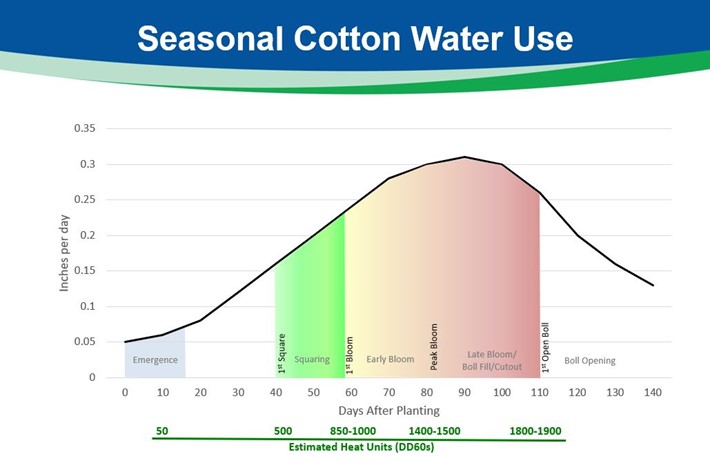PhytoGen agronomists study the effects of water deficiency in cotton and emphasize the importance of maintaining adequate water availability in irrigated fields.
Irrigation is a valuable tool used to enhance cotton yield and fiber quality across the Cotton Belt. However, many growers have a key question: when should irrigation stop to minimize input costs without compromising yield and fiber quality?
Before terminating irrigation, it’s important to understand the role water plays in cotton development, the factors that influence irrigation termination, and the risks of stopping too early or too late.
Why Water Management Matters in Cotton
Water plays several essential roles in cotton growth:
- Maintains turgor pressure. Strong plant turgidity protects structural integrity, enabling cell elongation and steady growth.
- Keeps plants cool. Through transpiration, water vapor escapes from leaves, helping plants regulate temperature on hot summer days.
- Enables nutrient uptake. Without water, essential nutrients remain locked in the soil, never reaching developing bolls.
- Drives photosynthesis. Water, carbon dioxide, and sunlight work together to produce energy for plant growth.
Seasonal Cotton Water Use and Development Stages
Cotton’s water demand rises as the crop develops, peaking during boll fill, usually 80–100 days after planting.
- Cotton is a more drought tolerant crop compared to other crops such as corn, sorghum, and peanuts.
- Cotton plants can require as much as 2 acre-feet of water throughout the season to maximize yield.
- Cotton has some flexibility when it comes to irrigation, but it is critical to maintain adequate moisture throughout the season.

Best Practices for Cotton Irrigation Termination
Consider these key factors when deciding to stop irrigation:
1. Crop Development Stage
Irrigation should continue until the bolls contributing to harvestable yield are fully developed.
- First bloom to peak bloom: Water stress during this stage can significantly reduce both yield and fiber quality. Plants establish harvestable bolls and develop fiber length, so deficiencies may result in shorter-staple cotton.
- Peak bloom through open boll: Water stress has a moderate impact on yield but can greatly affect fiber quality, particularly micronaire.
2. Soil Moisture and Weather Forecasts
Soil moisture levels and short-term forecasts are critical:
- Adequate stored soil moisture or expected rainfall may allow earlier termination.
- Hot, dry forecasts may require extended watering.
3. Soil Type and Field Conditions
Cotton typically uses 23–28 inches of water per season, with peak daily use around 0.3 inch.
- Coarse sand: Holds 0.25–0.75 inches per foot—requires more frequent irrigation.
- Silt loam: Holds 2–2.5 inches per foot—may need less water.
Adjust irrigation decisions based on soil water-holding capacity.
4. Visual and Physiological Indicators
Monitor plants for signs that indicate whether irrigation can be terminated:
- Boll maturity: Firmness, seed coat darkening, fully developed cotyledons
- Declining bloom activity: Approaching cutout (NAWF <4)
- Stress indicators: Leaf wilting or premature senescence signal plant stress —not an automatic reason to stop irrigating.
- Fields with nematode pressure may need additional irrigation due to weaker root systems.
Risks of Stopping Too Early or Too Late
- Stopping too early: May reduce boll retention, fiber length, and micronaire, decreasing yield.
- Continuing too long: Wastes water, increases pumping costs, delays maturity, contributes to boll rot and complicates harvest.
Finding the right balance is key to protecting both yield and lint quality while managing costs effectively.
For more information or tailored recommendations, visit PhytoGen.com/Team

